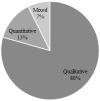COVID-19, Livestock Systems and Food Security in Developing Countries: A Systematic Review of an Emerging Literature
- PMID: 34064749
- PMCID: PMC8151861
- DOI: 10.3390/pathogens10050586
COVID-19, Livestock Systems and Food Security in Developing Countries: A Systematic Review of an Emerging Literature
Abstract
In this paper, we carried out a systematic literature review to document the emerging scientific knowledge about COVID-19 impact on livestock systems and food security in developing countries to identify gaps and possible avenues for future research undertakings. Specifically, we systematically reviewed 68 peer-reviewed articles extracted based on rigorous selection criteria from Scopus, PubMed and ISI Web of Science databases and published between December 2019 and February 2021. Our results reveal that livestock supply chains presented an important 'intermediary' pathway through which the pandemic affected various dimensions of food security in developing countries. Although the research response has been rapid in terms of both quantity and temporal succession, we find a highly suggestive disjunction in studies analyzing the interconnections between COVID-19 pandemic, livestock systems and food security in developing countries. With respect to the livestock supply chain, the bulk of the reviewed evidence focuses on production and consumption, whereas considerably less focus is given to the pandemic's impact on intermediaries within livestock chains, including traders, intermediaries and processors. The analysis of livestock supply chain resilience revolves predominantly around the 'absorbance' and 'recovery' phases of resilience, whereas only a small subset of the literature investigates actions taken by supply chain actors to 'plan' or to 'adapt' livestock systems in order to reduce their vulnerability and enhance their overall resilience. Furthermore, food security has often been narrowly defined, with the majority of articles focusing on 'availability' and 'accessibility' to food due to the pandemic, and other dimensions of food security, including utilization, stability and sustainability, have been widely neglected. Based on our findings, we recommend future research to examine the dynamics of propagation of COVID-19 impact through livestock supply chains in order to develop more targeted interventions that enhance the capacity of developing countries to cope with this and future disruptions and mitigate their food insecurity outcomes. To this end, more holistic, integrated and resilience-based approaches are much recommended to recognize the complex nature of livestock systems in developing countries and to address the multifaceted and widespread effects of COVID-19 on food security channeled through livestock chains.
Keywords: COVID-19; developing countries; food security; livestock systems; systematic literature review.
Conflict of interest statement
The authors declare no conflict of interest. The funders had no role in the design of the study; in the collection, analyses, or interpretation of data; in the writing of the manuscript; or in the decision to publish the results.
Figures







Similar articles
-
Beyond the black stump: rapid reviews of health research issues affecting regional, rural and remote Australia.Med J Aust. 2020 Dec;213 Suppl 11:S3-S32.e1. doi: 10.5694/mja2.50881. Med J Aust. 2020. PMID: 33314144
-
Exploration of Food Security Challenges towards More Sustainable Food Production: A Systematic Literature Review of the Major Drivers and Policies.Foods. 2022 Nov 25;11(23):3804. doi: 10.3390/foods11233804. Foods. 2022. PMID: 36496611 Free PMC article. Review.
-
A systematic review of the direct and indirect COVID-19's impact on food security and its dimensions: pre-and post-comparative analysis.BMC Public Health. 2023 Nov 20;23(1):2298. doi: 10.1186/s12889-023-17104-6. BMC Public Health. 2023. PMID: 37986174 Free PMC article.
-
Current coronavirus crisis and past pandemics - What can happen in post-COVID-19 agriculture?Sustain Prod Consum. 2022 Mar;30:752-760. doi: 10.1016/j.spc.2022.01.007. Epub 2022 Jan 15. Sustain Prod Consum. 2022. PMID: 35071718 Free PMC article. Review.
-
Three years into the pandemic: Insights of the COVID-19 impacts on food security and nutrition in low and middle-income countries.Heliyon. 2024 Mar 30;10(7):e28946. doi: 10.1016/j.heliyon.2024.e28946. eCollection 2024 Apr 15. Heliyon. 2024. PMID: 38596121 Free PMC article. Review.
Cited by
-
Social embeddedness of pig value chains in Myanmar and its implications for food and nutrition security.Food Secur. 2022;14(4):965-976. doi: 10.1007/s12571-022-01278-9. Epub 2022 Mar 24. Food Secur. 2022. PMID: 35911868 Free PMC article.
-
Longitudinal study of the impact of the COVID-19 pandemic on diet and physical activity among Latinos of Mexican ancestry.J Transl Med. 2024 Apr 9;22(1):342. doi: 10.1186/s12967-024-05007-y. J Transl Med. 2024. PMID: 38594708 Free PMC article.
-
Eating Behaviour Changes during the COVID-19 Pandemic: A Systematic Review of Longitudinal Studies.Int J Environ Res Public Health. 2021 Oct 22;18(21):11130. doi: 10.3390/ijerph182111130. Int J Environ Res Public Health. 2021. PMID: 34769648 Free PMC article.
-
Triple-crises-induced food insecurity: systematic understanding and resilience building approaches in Africa.Sci One Health. 2023 Oct 29;2:100044. doi: 10.1016/j.soh.2023.100044. eCollection 2023. Sci One Health. 2023. PMID: 39077040 Free PMC article. Review.
-
BMI Increases in Individuals with COVID-19-Associated Olfactory Dysfunction.Nutrients. 2023 Oct 26;15(21):4538. doi: 10.3390/nu15214538. Nutrients. 2023. PMID: 37960191 Free PMC article.
References
-
- FAO . Impact of COVID-19 on Agriculture, Food Systems and Rural Livelihoods in Eastern Africa: Policy and Programmatic Options. FAO; Rome, Italy: 2020.
-
- OECD . COVID-19 and the Food and Agriculture Sector: Issues and Policy Responses. OECD; Paris, France: 2020. p. 12. - DOI
-
- Abu Hatab A., Cavinato M.E.R., Lagerkvist C.J. Urbanization, livestock systems and food security in developing countries: A systematic review of the literature. Food Secur. 2019;11:279–299. doi: 10.1007/s12571-019-00906-1. - DOI
Publication types
Grants and funding
LinkOut - more resources
Full Text Sources

